30 Simple Ways to Be Prepared for a Blizzard
Do you feel like you need to be prepared for a blizzard? Winter storms may not seem nearly as dangerous as severe weather-related challenges, but they still create many risks that many people don’t consider.
Frostbite, hypothermia, carbon monoxide poisoning, and heart attacks caused by overexertion while shoveling are all serious issues that are pretty common. Though you may look outside and think it’s only a couple of feet of snow, it could be deadly for someone else.
From DMWalsh: With all the blowing snow during a blizzard, folks need to double-check their furnace intake and exhaust so that they don’t get blocked by snow or ice (if you still have a chimney, great! but most high-efficiency furnaces have direct venting.) Same thing for generators, a clogged intake or exhaust can ruin your day.
Taking precautions before a winter storm hits your area is so essential. I also want to share what your family should be doing and not doing during and after a blizzard. Keep reading to learn more about preparing your family and home for a potential blizzard. In case you missed this post, How To Make Your Own Emergency Car Kit
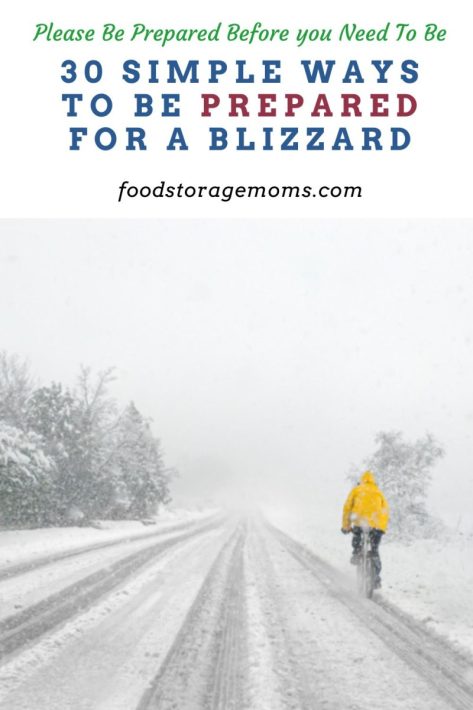
30 Simple Ways to Be Prepared for a Blizzard
Precautions to Take Before a Winter Storm
A blizzard isn’t something anyone should take lightly; when a winter storm warning has been issued, you must be prepared before it strikes. These are several tips to remember:
1. Furnace Working
Ensure your home’s furnace is working correctly and hasn’t been too long since its last maintenance. Also, it wouldn’t hurt to change the furnace filter if it’s been a while. The heating and air conditioning experts suggest a change every month or two, depending on the time of year and how much the systems have been used since the filter was last changed.
We were surprised when a repairman told us to consider a filter that wasn’t as restricting to the airflow. He said that unless we had allergy issues, some less expensive and less restrictive filters do a good job and allow more air to flow throughout the house. Test some out and see how your home reacts to the change.
2. Weather Radio
Keep a weather radio nearby, and stay tuned for critical weather updates. Failing to listen to these cautions could have a devastating impact on not only your own life but also the lives of each of your family members. Emergency Radio
Also, consider getting a radio that runs on batteries and can be powered by a crank or solar. Having extra batteries is always something we need to stay on top of, too.
3. Winterize Your Home
Winterize your home before the first storm hits. This includes tasks such as insulating your pipes, particularly those pipes that are running along outside walls. (Allowing a trickle of water to flow through them to help prevent them from freezing during icy and windy conditions is also something we should keep in mind.)
Make sure your chimney flue is clean and allows for the free flow of exhaust, insulate doors and windows if you’ve seen cracks or the sun shines through when they’re closed, and stock up on enough non-perishable food items to hold your family over for a minimum of three days or longer.
4. Stock Fuel
Stock up on firewood, propane, and butane. I always tell my readers to keep their car’s gasoline tank at least half or above. Please use these stabilizers for gasoline and diesel if you have some stored:
Remember to have all flammables safely stored away from the house. A remote shed may be the best solution.
5. Prepare for Power Outages
It’s best to plan for the worst and assume you’ll lose power, so you should have your generator tested and ready. Note that most generators aren’t designed to back up multiple appliances.
They may be key units to keep running if you have much perishable food in a fridge and/or freezer. If the generator is powerful enough, you’ll want it hooked to your furnace so the fan can operate.
6. Smoke & Carbon Monoxide Detectors
Ensure your smoke and carbon monoxide detectors are working correctly and have fresh batteries. Carbon Monoxide Detector.
Here in Utah, they suggest you also have a radon gas detector. Check your area for that exact issue; they aren’t that expensive.
7. Check the Sump Pump if Applicable
Check your sump pump to ensure it works correctly if you have one. When the snow starts to melt, water damage in your basement is a possibility, but a properly working sump pump can save the day.
8. Winter Weather Kit
Put together a winter weather kit for each member of your family. This should include a flashlight, batteries, tools, a first-aid kit, hand warmers, and extra layers of thick warm clothing. Flashlights with Batteries
I’ve mentioned before that I like solar-powered flashlights. I always have some on my window sills to keep them charged up, rain or shine.
9. Stock Blankets
Lay out several dry blankets each family member can wrap up in to keep their body heat in.
10. Keep Cell Phones (Mobile Device) Charged
Charge your cell phones and other electronics that you will use to get a hold of anyone and let them know whether you’re okay or need help. You can buy special power bank units as backups if the power goes out. They are handy to charge phones, laptops, notebooks, etc.
Ways to Prepare Your Vehicle For a Blizzard
11. Maintain Your Vehicles
Make sure your vehicle is in good working condition before the storm hits. This means checking the tires, brakes, and windshield wipers and ensuring you have enough washer fluid. It’s also a good idea to keep a winter weather kit in your car, similar to the list I provided above for your home.
Ensure your car or truck has the proper antifreeze level in the radiator. Nothing is worse than having extensive engine damage because you didn’t check the temperature range of your car’s cooling fluids. Over time, the antifreeze concentration can diminish as you add new water to the system, so have it checked occasionally, just to be sure.
12. Keep Your Gas Tank Full or at Least 1/2 Full
As mentioned above, keep your gas tank at least half full during the winter. This will help prevent the fuel from freezing due to moisture condensation. A full tank is even better.
This also provides the added confidence that if you need to travel, which isn’t generally suggested in a blizzard, you have enough fuel to get you where you need to go.
13. Make A Plan For Evacuation
Know where you can go for shelter if your power goes out for an extended period or your home becomes unsafe. There may also be safe havens provided for those who need food. Do your research now before you need to know these safety precautions.
14. Check on Neighbors
Have a plan in place for how you will check on older or vulnerable family members, neighbors, and others you care about. Consider walkie-talkies if they live close enough since replaceable batteries can power them. Do some tests to ensure all needed parties have them tuned to the same channel.
What to Do During a Blizzard
15. Be Ready To Hunker Down
As the snow starts to fall and the winds start to pick up, it’s best to stay put and take shelter in your home or wherever you feel safe. The home scene is probably the best place to hunker down if adequately prepared. It is all part of an overall plan. Start now rather than wait. August is a great month to assemble what you need for the winter months.
16. Stay off the Roads
Avoid getting out and driving on the roads, if you can, since you may not be aware of various hazards during a bad storm. Hand Warmers Are Awesome!
17. Have a Vehicle Survival Kit
If you’re trapped or stuck in the snow in your vehicle, stay calm while staying put. Venturing out in the cold will only allow hypothermia to set in faster.
18. Be Careful When Shoveling Snow
Avoid using too much energy when shoveling snow or walking out in the snow. Overexerting yourself can lead to a heart attack.
19. Stay Warm and Be Cautious
Make sure that you limit the amount of time that you’re outdoors. Take some time to pause between projects like clearing snow for neighbors. If it’s windy, hypothermia can set in faster than you expect.
20. Layer Up To Stay Warm
Wear multiple layers of clothing and proper snow protection such as boots, gloves, winter jackets, and face protection.
21. Beware of Frostbit & Hypothermia
If you’ve spent much time outdoors, watch for signs of frostbite and hypothermia. These include numbness, slurred speech, and drowsiness.
22. Drink Fluids and Stay Hydrated
Be sure that you’re drinking enough fluids, but avoid caffeine and alcohol since they can hasten the onset of hypothermia.
23. Clean Your Chimney Flue and Ventilate the Room
If you have a fireplace, use it during the coldest times of the day and night to efficiently use any coal and wood. Be sure to keep flammable items like clothing and paper goods from the fireplace. Be sure to open the flue for good airflow when in operation. If not being used, close that flue so the heat doesn’t just go up the chimney and outside.
Remember that using kerosene indoors is only safe if the room is adequately ventilated. People die every winter from using a kerosene stove to heat their homes, and they keep all the windows closed.
What to Do After the Blizzard Has Passed
24. Be Careful After The Storm
Once the weather has calmed down, there are still a few things you need to be aware of before venturing back outside. If the sky is clear, it’s probably colder than expected. Having snow on the ground also makes the environment colder and less forgiving.
25. Be Aware of Your Surroundings
Avoid walking or driving through deep snow drifts, as they could hide downed power lines or other obstructions.
26. Watch Out For Icy Sidewalks and Driveways
Be cautious when walking on sidewalks and driveways cleared of snow. The surfaces may be icy and slick, mainly if the sun was out for a while and melted things.
27. Watch for Fallen Trees
Watch for fallen tree limbs and other debris the storm may have left behind. This also applies to areas you’re trying to clear with a power snowblower. There could be some risk of injury and damage to the equipment if you hit fallen tree limbs and branches.
28. Be Cautious Re-Entering Your Home
If you had to leave your home during the storm, be cautious when re-entering, as there could be structural damage you’re unaware of. Be sure to walk around the home and look for anything out of order. Spend time out back and look for sagging patio roofs, furniture blown out of place, etc.
29. Stock Food, Water, and Supplies
Do an inventory of your food supplies and restock them as necessary when it’s safe and convenient.
30. Monitor Weather Updates
Even though the storm has passed, monitor any weather updates if another storm system is heading your way.
Why is Visibility an Issue During a Blizzard?
Blizzards aren’t just heavy snow storms; they entail strong winds. If snow blows, it will be tough getting around, whether walking or driving—blizzards cause snowdrifts to form, indicating that the wind has been influential in that area. Driving becomes much riskier if you can’t see what’s ahead or even where the lanes of the road are.
Who Normally Announces Storm Warnings?
The National Weather Service is usually responsible for announcing or issuing storm warnings. That’s one of the reasons I suggested above: you have a quality weather radio ready to keep you fully informed.
What Besides Insulation, Weather Stripping, and Caulk Should I Use to Keep the Storm Out?
Here in Utah, we’ve always put storm doors on the main entrances to our homes. They’re great since you can keep the cold wind and snow out during the winter and install screens for good airflow during other seasons when you want fresh air in the house.
Storm Windows Do Make a Difference
It’s hard to believe, but many American households still have single-pane windows. If your family is one of those, you may want to upgrade the value of your home by installing double or triple-pane windows. There may even be some tax credits your state allows when you make your home more energy efficient.
If you live in a frigid part of the country, consider going the extra step by installing storm windows. They amount to an additional window system on the outside or inside of your current windows, thus providing another level of protection from letting the heat or cool air into or out of the house.
Yes, there is some expense when replacing windows or installing storm window systems, but you’ll be surprised how fast you can recoup the cost when you see the savings in your monthly heating or air conditioning bills.
Wind Does Affect the Effective Temperature Outside
Often, we hear the term “wind chill factor” when the evening weather report is broadcast on TV or radio. This means the temperature you feel when you’re outside during the cold, and a windstorm comes up. It is incredible what a difference the wind can make, and you need to be aware of the temperature to dress accordingly.
Things You Should Consider During the Winter to Gain More Traction From Your Tires
Those who’ve grown up in cold and stormy climates know that winter and snow storms add a new dimension to driving. Having good quality tires can make a real difference when it comes to safe driving. Yes, you can trade off and replace those summer tires with snow tires, but you may also need to consider carrying some tire chains in your trunk during the winter.
The chains add another level of traction, particularly if you have to drive on packed or icy roads. Depending on your vehicle, they can be challenging, especially if you’re trying to put them on during a storm.
Having studded tires used to be a popular choice, but due to the damage they cause to roadways, many states have restricted their use.
Final Word
By following these tips, you can help to ensure that you and your family stay safe during winter and are prepared for a blizzard. What would be some other important tips to follow for someone who’s caught in the middle of a snowstorm? I’d love to hear your thoughts! May God Bless this world, Linda
Copyright Images: Man on a Snowy Road AdobeStock_401995953 by Mikel Allica, Blizzard and Snow AdobeStock_284467154

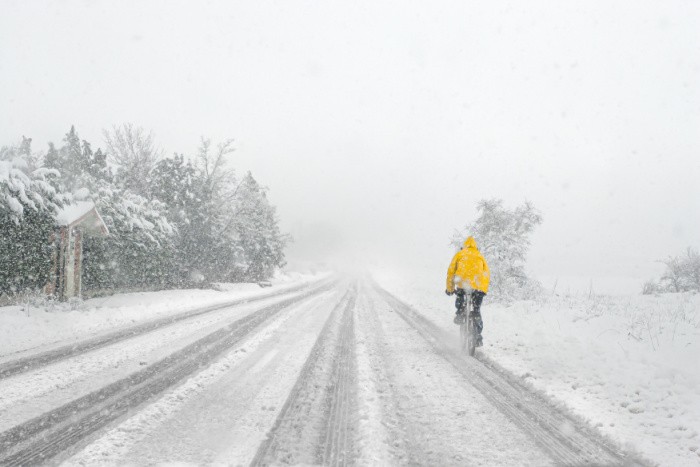



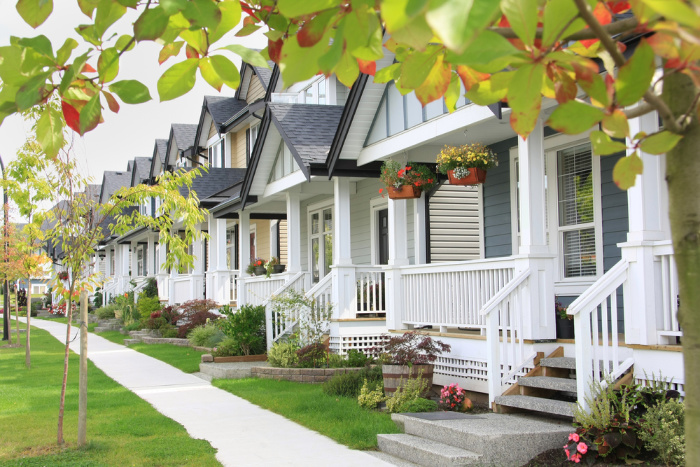
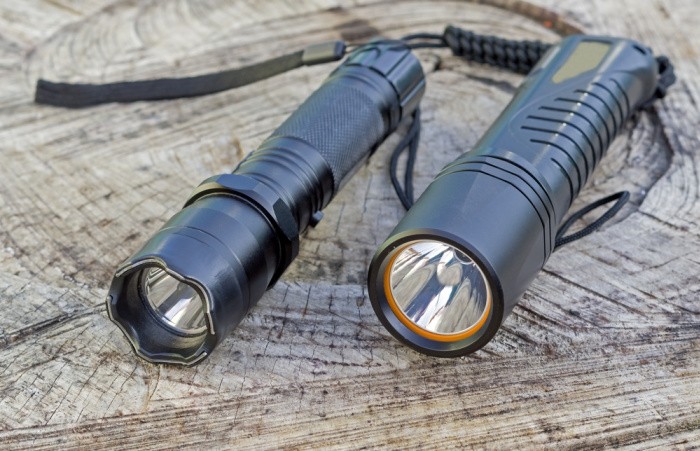
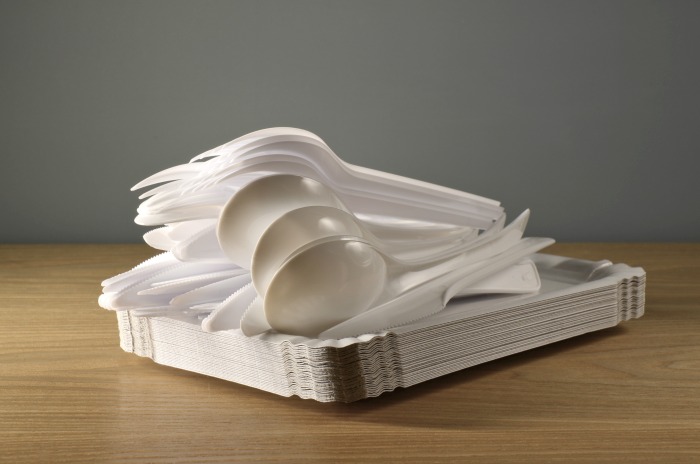
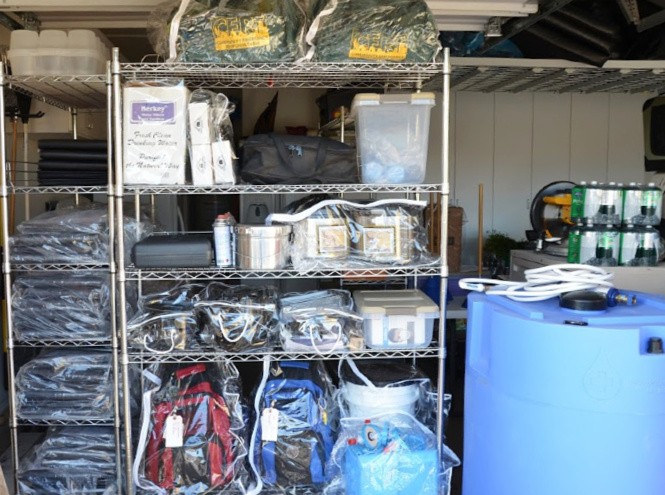













Good list!
I only run the cheaper filters. Since I’m in and out all day it does zero good to have hypoallergenic or hepa style and in winter there shouldn’t be a lot of allergens anyway.
This is the time the vehicle bag grows. Insulated coveralls, blanket, insulated gloves, stocking cap, hand warmers, merino wool socks and and set of heavy boots all go in a additional bag. I always leave the house appropriately dressed but things happen and if you get wet you’ll need other stuff.
Check your 4×4. I’ve seen computer and vacuum failures at the worst times. Check the winch and winch line if you’ve got them. Check your air compressor in case you need to air down and reinflate.
Fire up the generator and throw 1/2 load on it to test.
Mostly just pay attention to the weather and don’t be the 11th hour milk n bread on tv.
Hi Matt, thank you for your kind words and great advice. I got the giggles over the 11th Hour milk and bread on TV! I need to go add my vehicle emergency bag to the post. Some things we take for granted. Great reminder! Linda
Very good and right on list, Linda. Thank you!
I’m reminds to make sure to be ready and not miss anything you have on the list to be ready.
It gets super cold in Iowa in the winters and prone to blizzards and power outages.
I’m looking for scrap wood to build an enclosure closer to the back door for the generator. This year I’m not dragging it out of garage when needed.
Thank you again for such a complete list of things to do in order to be ready.
Hi Cindy, thank you for your kind words, my friend! Wow, I don’t think I have ever been to Iowa! I would love to see every state in the USA!! Stay safe, stay warm, Linda
2 years ago we purchased a plastic molded outdoor tool storage box that perfectly fits our generator so it is always ready. My husband cut an opening in the side to vent the generator when running. The generator is conected to our electric panel so that we only have to flip one switch. It is configured to run refrigerators, freezer, part of kitchen wall circuits, part of living room. Works great.
Hi Mt.Grammy, those generators would be such a blessing to so many people! Great idea to keep it covered to protect it from the weather. Linda
Great idea to get a outdoor tool storage box and put a opening in for venting it. And great it’s connected to the electric panel too.
You’ve given me perhaps a simpler idea. Thanks for sharing
Hey Linda just an FYI, Todd has sold Prepper Website and now has a new site, http://www.ReadyYourFuture.com
HI Cindy!!! I did not know thank, thank you!! Linda
Hi Cindy, the link does not work. It’s probably being worked on. He must be hosting with Cloudfare. Thank you for letting me know. I’ve been so busy I haven’t checked in with him lately. He’s the best! Linda
Hi Linda,
I think he’s having trouble with his server sometimes so hope will be up and running soon.
Hi Cindy, thank you for the heads up! Linda
Ah, so many comments I could make but no one really wants to hear them. I do have about 7 cords of firewood for our woodburning stove so that makes me feel somewhat secure…AND I have enough quilts I’ve made to blanket the neighborhood! We don’t get the snow like we used to here in N. Nevada and I miss it. I don’t miss shoveling it but a self-propelled snowblower helps…somewhat. As we’re hovering around 103 for a week solid, I’m sooo looking forward to winter!
Hi Robbie, I hear you about shoveling snow!! Thankfully our son-in-law does our since we moved back up north. 7 cords of firewood are awesome!! Linda
Great list Linda! We are finishing up winter preps. We are due for an ice storm here. There’s one every year someplace in the state and we’ve had some close by but have just missed us. We’ve gone through them before and know what to do. I almost think it’s easier since we’re retired and don’t have to get to work!
HI Paula, it’s great working from home and being retired! Life is good! We do not have to go out if we don’t want to! I love hearing you’re finishing up your winter preps! Linda
We bought a larger generator and I’m so excited about it! Almost as good as Christmas! LOL
Hi Paula, oh that is a cartwheel moment! I LOVE hearing this!!! Linda
I put boots in my car that are good to -20. I normally wear athletic shoes, which would not be good if I had to walk in a storm.
Hi Janet, oh my gosh, that’s the best idea ever! Now, that I live back in northern Utah I need to get some of those boots. Great reminder! Linda
There is two suggestions I would make…….DON’T plan special events ….. We had just bought our first home with two kids, and were hosting a house warming party. The Blizzard of ’77 had other ideas. If we had not canceled the party that morning, we might have been stranded with about 50 friends and family for almost a week!! DON’T plan weddings…. The October Surprise storm in 2006 left us without power for almost a week and could have ended up canceling the rehearsal dinner for our son and his bride.
We known enough to stay off the road and leave the dangerous driving to fools without the brains that God gave a gopher.
We have a service to shovel and plow, so I can enjoy the beauty of the snow, whole knowing my husband won’t be out in it. Great time for roast in the oven.
HI Chris, great advice on those months for special events! You nailed it. I did giggle over the fools without the brains that God gave a gopher…..LOL! Linda
Linda, I had my husband read this article, to make sure we are ready. On #1, we have upgraded our furnace filters to medium grade to cut down on the dust particles, but we bought enough for two years, and switch them out every three months. On #9…..we have 12 sherpa and faux fur blankets for two people….yes, I get carried away, but they add so much to a room hanging on antique wooden ladders. Rhonda is right, when we qualify as the elderly in #14. I do jar candles and flashlights because propane and kerosene make me nervous. When winter settles in so do I.
Hi Chris, I do not do kerosene lamps either. It’s just me they make me nervous. I’m in the elderly party group as well, life is good! Linda
Chris, your story about the almost-house-warming reminded me about a story of a pub somewhere in Great Britain–Yorkshire, I think. A snowstorm hit, stranding quite a number of people–and a few dogs! Thanks to the well-prepared and well-stocked pub owner, everyone made out just fine–and had a great time! So good that they’ve actually had reunions!
I love that story, Rhonda. Thank you for sharing. In our case, we had just moved in the week before Christmas, so while we had plenty of goodies for the planned party, daily needs, not so much. I do remember waking to the sound of a new neighbor we had barely met, starting to clear our sidewalk. We were blessed with several great neighbors and friends.
HII Chris, aww, I love this story! Having great neighbors is wonderful. I love it when we have no idea who they are yet and they show up to shovel snow! Linda
Hi Rhonda, oh my gosh, I LOVE this story! Thanks for sharing such a positive way almost a housewarming story!! And reunions, how neat is that!!! Linda
One thing I do know, is we have never lost our natural gas service. It is the reason our whole house generator is run on natural gas. It may not serve us in every emergency, but it is the best we can do.
Hi Chris, that’s awesome! We have never lost our natural gas service either. Linda
Blizzards are common here, we get 2 or 3 (or more) every year. We are lucky and have never lost power (thank goodness for buried power lines) or gas during a winter storm. The other thing we have to prepare for is extreme cold. We usually have at least one week where the actual temperature or wind chill factor is below -20 degrees.
One thing that I saw somewhere was to use the solar lawn lights (the ones you put along your sidewalk) in jars or vases in case of lights out. Pretty simple and inexpensive. We pull our solar lights out before the ground freezes for the winter and this year I’m going to store them in front of a window so they will stay charged.
A good vehicle emergency kit is so important. Almost every year at least one person (or carful) gets lost in the snow and ends up dying from exposure. I think the worst was when a college couple got lost and was able to reach 911. They didn’t know where they were and visibility was so low they couldn’t describe anything. Eventually the cell phone died. The couple was found the next day, they had gotten off the road was were driving through a farm field. We have better GPS tracking on phones now so hopefully that won’t be repeated.
Also be aware of your neighbors. The ones who are experiencing their first blizzard may be totally clueless. I know we were. Midwest blizzards are nothing like the Virginia snowstorms we grew up experiencing. After the first snowstorm, hubby bought a snowblower, although during most blizzards unless he goes out to clear the driveway and sidewalk several times during the storm, the snow is too deep to use the snowblower. When the kids were old enough to help, we bought extra snow shovels. We also learned about something called a snow rake to clear deep snow off the roof. It was a rapid learning experience for us; we had more snow our first year here than in any of the 22 winters since then.
I try to keep the ingredients to make a nice hearty stew or chowder on hand and if a blizzard hits, I start this in the crockpot and we pull out games and just enjoy the weather mandated break from regular life.
Hi Topaz, I can’t imagine -20 degrees! YIKES! We always had a snow blower when we lived up north and now we’re back here. But our son-in-law will do the shoveling. And use the snowblower when needed. It’s crazy I remember one year we had so much snow people were using those snow rakes to get the snow off their roofs. It was so cold it didn’t melt and we were all afraid our roofs might cave in. I love starting a crockpot and taking a break from regular life. The snow is beautiful when it falls but then it looks dirty in a few days. We all need that snow right now. Dirty or not, we need it. Linda
About that #14… It’s weird, being the same age as old people…
Multiple layers of prep are good, in case there’s anything like our Blizzard of ’78 (the one that shut down Boston’s Rte. 128 for days on end) or the Ice Storm of (I think) ’08–both left us without power for nearly 2 weeks. We now have an on-demand generator, but the kerosene lamp still hangs ready in the kitchen, as one example!
Adding to blankets–sleeping bags are very cozy. If you have matching bags, they can be zipped together for sharing body warmth with your partner. And if you find one with a broken zipper, take it anyway–makes a great comforter! (And extra blankets, etc., are great for laying over the freezer for extra insulation.)
Re. people “from away” who don’t understand blizzards (or even simple cold and snow)–yep, that’s my Memphis husband. The stories I could share… Like the time he pulled the snow brush/scraper out of the vehicles, at the beginning of March–because “winter was over”!
Hi Rhonda, oh my gosh, the snow scraper, my husband would do the same thing. LOL! We have had snow drift on the freeway in April…I get it. Sleeping bags are awesome! Great reminder to use them as comforters even if the zipper is broken. Life is so good, Linda
Just wanted to add that with all the blowing snow during a blizzard folks need to double-check their furnace intake and exhaust that they don’t get blocked by snow or ice (if you still have a chimney, great! but most high efficiency furnaces have direct venting.) Same thing for generators, a clogged intake or exhaust can ruin your day. I make the rounds every few hours during a blizzard here in MA just in case….and yes I love natural gas since it can keep my standby generator humming in most emergencies.
Hope folks are staying safe with the current storm.
Hi DMWalsh, oh this is critical, I need to go add this to the post, thank you. I have a spout out my backyard on the house for a BBQ (gasline, could I hook a generator to that? I mean I would hire someone. I was going to ask Harry and Matt if it would work. Thanks, Linda
If your generator runs off natural gas, then I’m sure a plumber could hook it up for you. Just make sure whoever does the work is licensed since natural gas can be a serious hazard if it leaks….that’s when houses go boom. 🙁
Oh, and if a generator says it runs off propane, that doesn’t mean it will work with natural gas without modifications. My Generac generator has a manual adjustment inside to switch from natural gas to propane, but portable generators may not have that feature. Better safe than sorry!
Hi DmWalsh, I remember our BBQ had to get a modification adaptor to use natural gas. We would only hire a licensed installer, I totally agree with you. Not sure its in the budget but I would like to get it plumbed ahead of time. Great advice, Linda
Also for those who have gas powered clothes dryers… their venting must be kept free from ice as well…for same reasons.
HI Denise, you are so right! Thank you, Linda
Been through my share of blizzards and one thing people need to prepare is your car. Yes, keep maintained, blankets, but there’s additional things you can do. You may be stuck on the side of the road for awhile. Have some chocolate bars, energy bars, water and nuts stored away somewhere inside your car. You may not be able to get to trunk. If you have the room also put like a Tea Candle or similar on an empty METAL coffee can, and matches – light it up to get a little warmth.
Hi Barb, oh yes, being warm is critical and so are having some sanacks. Love this, thank you, Linda
With the wind that also accompanies the storms, if you do not lose power or water and you are doing laundry, make sure your dryer vent is clear!! A friend was drying her laundry and hadn’t cleared the exhaust vent which caused a fire in the laundry room. Also, it would be a good idea to check the dryer vent/tubing at least 2X per year. Don’t need a laundry room fire on top of blizzard concerns.
As for lighting if the power is out, kerosene lamps do create some warmth. I was in a power outage for 2 weeks one time due to an ice storm – no snow to speak of but the temps were so low as to cause trees to snap off causing damage to the power lines. My daughter and I hung a quilt between the living room and the kitchen and made our beds in the kitchen. We had 2 kerosene lamps going and it provided enough warmth to keep us comfortable. I do recommend cracking a window open a few inches though!! Also, we lined one of the sinks with foil and placed a couple of 2 or 3 wick candles in the sink and finally placed an oven rack over the sink. I was able to heat water for coffee, tea, hot chocolate as well as for heating soup for meals. The foil just ensures no wax goes down the sink drain in the event that the candle container breaks. We were quite comfortable and a couple of neighbors stopped to see why we had lights!!
Hi Leanne, you are such a great example to us and your daughter! The foil in the sink is awesome! We know how to survive that’s for sure! I know people who have kerosene lamps and love them, I have so many battery and solar lanterns I’m good to go. I can’t store anything in this small house! LOL! I love that the neighbors wondered how you had lights, love it! Linda
Sitting here in KY with 11+ inches snow, 1 1/2 inches of ice, 1-3 inches more snow coming today and another snow storm due in 4 days, I cannot agree with all these recommendations more! Experience can be the best teacher. 2009 ice storm in the city with underground utilities, we went without power for 1 week. Hubs bought a smallish gas powered generator back then and since moving to the country 5 1/2 yrs ago, we now have a solar. Always depended on our gas grill to cook, we moved to a gas stove with kitchen update last year. We now have 1 fridge and 3 freezers, so he bought a larger generator (last one within 100 miles) several days ago.
I’ve never been an “empty” pantry person but hubs’ farming family and living farther out from supplies, I love that any day of the week, I can source our supplies for any meal.
Keep these great instructions coming! You’re the best!
Hi Marilynne, oh my gosh, that’s a lot of snow and the ice makes it even worse. And another storm in 4 days, oh my gosh, that’s a HUGE storm! Thank you for your kind words! I feel the same having a “full” pantry and can fix any meal anytime. We don’t have any meat in the freezer except bacon. LOL! I’m using my freeze dried meat in meals these days. My husband is 78 and I will be 75, so we are using our freeze dried. My kids will not want it and its good stuff. So we’re living off all of it. Life is good. I would love a generator, I do have a solar generator that will work for some stuff, my oxygen concentrator will be the first choice. Having a gas stove is a blessing, I had one installed in this house. If the power goes out I can use the stove. Stay warm and safe when shoveling. Linda
Linda we have a gas oven and stove top… our next small backup will be a unit to back up the electrical on the stove..so we can use the oven../or the furnace back up… specific to it only… ). . one of those things like is used to maintain power on a computer would work..
.I can cook any variety on the stovetop including biscuits and corn pone.. + we keep extra home made sourdough loaves in the freezer.
Marilynne, I am well south of you.. we got a dusting and had thunderstorms while you were getting ice /snow…I am glad you are well prepared… I know some are not.. nothing i can do from here. Yes we are to get intense weather -what looks to be ice…in week between 11th and 18th… according to early models… too far out to know…
we also have more than one refrigerator and freezer. as i remove things from the freezer i replace the space with cleaned and sanitized cola bottles of all sizes filled and collapsed just a tiny bit, with filtered water, or deep well water. the extra ice will help keep frozen meats frozen harder and longer than a hap-hazardly packed freezer. i have filtered water in house in small bleach, vinegar and plastic milk of 3/4 gal and gallon. (jugs since i can no longer lift anything with significant weight/volume. they take up significant space,not having water stored is not an option.5 gallon buckets and even kitty litter buckets do work for this as well.especially useful for bathroom use, washing and flushing…
I have had to… “Face it :…if I have to dig in it more than 2 times to get a needed item- it becomes harder to find other things.( so i tend to place my specifics in zones.of the freezer.) by filling the space with water you have water when it melts for drinking and the ability to keep freezers stable for longer periods- using less fuel/ electricity.
HI Denise, great tips for all of us, thank you, Linda
Hi Linda,
Here in Sweet Springs, Missouri we just came through a blizzard. Here are some animal ideas. I had several days to prepare. I knew on Monday last week that arctic temps were coming, but I did not know about the snow. I added another bale of straw to my garlic and I am so glad I did. Tuesday it was forecasted only 1-2 inches of snow then Wednesday upgraded to 22 inches. I worked on my chicken coop for 3 days getting it ready, closing up gaps where snow would blow in. I added more straw for them. I used plastic coated cat litter bags to stuff in lower gaps with a screw driver. I found barn tin and used bungee cords to hold in place. I already had clear plastic shower curtains on the pen walls, they do have 3 inches at the top for ventilation. I do not use a heat lamp or heater in my coop. It is not needed. They huddle together and I do not want to risk a fire. I have a heated dog water bowl that holds a gallon of water. It works great for chickens. I change it a couple times a week, Saturday before it was supposed to hit I made sure they had fresh water with 1 drop of poultry Vet RX for respiratory. I sprinkled a few drops of Vet RX and dill weed in their boxes of straw. I knew I would not be able to get out there. I normally go out every morning with feed and afternoon to give treats. I got the idea to put 3 pans out there and fill with their feed, red pepper flakes, cracked corn, cumin seed, and grit, enough to last a few days. I also filled a roaster pan with cat food for the outside cats who sleep in the shop. I am thankful that God gave me these ideas because this is the first big winter storm I have had out here by myself since Tom died. The storm started Saturday afternoon about 3 pm and was over early this morning. We had freezing rain, sleet, heavy snow totaling about 17 inches. The drifting is bad. I am stuck here until it melts or someone comes and digs me out. And we have arctic temps all week. But I have everything I need. I did not have to go buy anything more than what I normally buy each month on the 3rd, which is mostly cat food and chicken feed. Because I am prepared. It is shocking how many people are not prepared and they go empty the stores the day of the coming storm when they knew all week it was coming and gripe on facebook about empty shelves. I carried all the wood I could get inside throughout all last week, some each day. I have not used it yet, I was saving it in case I lost power. Several nearby towns did loose power.
I just wanted to give the ideas I got about animal preparedness in a threat of a winter storm. I feel like God just kept guiding me as to what to do each day.
God bless you Linda! Love and Hugs!
Jackie Perkins
Hi Jackie, i was just thinking about you! I’m so glad you are so prepared and you grow the best garlic in the world, my sweet friend! You’ve got this girl! God bless you, Love and Hugs, Linda
Hi Jackie, What a thoughtful post… It sounds like you have used everything on hand to the best of your ability with foresight.
Here are a couple more ideas for the next round….and this is my method.. for the securing of what i have..( This is how i do what i have chosen.).
DO stock the clay kitty litter and keep inside the door of your entrance/exit you use most often… if snow and can sweep steps/porch before it melts .. if not sweep what is possible and sprinkle the area well with kitty litter and or salt…to give you traction… we must always be mindful to not fall and use every protection we can…. it is not the fall, but the landing that puts many people in need of extended medical care…. also always dress for heavy winter even if intending to be out only a few minutes.. i used this last year on our asphalt circle i must cross to go to our areas i must service..
for the hens health in addition to the things you have mentioned. if you have essential oils… i take a bout 2 cups of their layer pellets and add oil of oregano and essential peppermint oil ( 6 drops of each)to 2 tbsp of cooking oil-( i use olive )and and blend that with the 2 cups of pellets..both help respiratory issues and are safe for chickens of all ages.anti bacterial , antiviral,and anti-fungal. i place that in a small feeder/separate from the others..
I wrapped my open,sided, covered dog kennel with a roll of clear plastic..10x 20 roll x 2…( a tarp and fiberglass sheet cover door).They have a separate roost/laying area.and they have, I leave venting…under eaves.. I do use lighting(14 hour on a cheap timer, gives me enough eggs for our family. and heat lamps in my areas for animals, i have
kits/rabbits in that run too..in generous areas… I secure each one with 3-4 tethers.(clamp,.. electrical line, and bungee from two directions…the heat lamps for bunnies are on wire./metal rest.,/clamped …one that is less secured with bingee…has a wire freezer basket protecting it…from falling or having anything get close to the bulb.. i just got thru placing one pointing close/down on my biggest metal watering container. it has 4 tethers. I also check every heat lamp to make sure the clamps on the flange are tight- 2x month.
…. 2 years ago i had to bring 2+gallon container in the house to warm/fill . we had record cold. Global warming did not hit here that year. (LOL)
Our wind chills are no where near yours but once a day is all i am going out.Minimizing opening up the area, keeps the temp up.( windchill was 12 when i came in.). the area warm enough i won’t worry about water freezing unless we do loose electric, or our temps drop below 20 for extended time, should we loose power.
. I keep feed and water hanging on bungees in kitty litter jugs staged during expected weather so it lessens the things i am required to bring to the coop.. ..i put pine sawdust/shavings (free)under my roosts, under the straw in the nestboxes. and in the rabbit poo areas. and gave plenty hay and i have extra feeders for every critter. Rabbits put straw in their water to prevent it from freezing hard… who’d a thunk it?
Hi Denise, wow, you have this down pat, girl! I love that you are sharing your wisdom! Linda
There is another thing that can be done for windows… get some fo the clear bubblewrap, cut to size for your window, and dampen it. put it against window and it will allow light in, and block some of the cold exchange.
HI Denise, WHAT? Oh my gosh, this is a nifty trick, thank you!! Linda
Hi Linda, Happy New Year to all! We dodged a bullet today as far as snowfall, less than an inch. But I heard on the evening weather report that we may get snow on Saturday, 9 or more inches depending on how the wind blows. I am so glad I went to BJ’S and got tissue, paper towels, water, garbage bags, laundry soap and Downy. I’m ready, food in the fridge, freezer and cabinets, making meat sauce for dinner tomorrow and will freeze what I don’t use. Glad to hear everyone made out ok with the weather we are having. Let’s hope the snow doesn’t last too long, the porter will shovel and put salt on the sidewalk, I live in an apartment building. Here’s to some hot cocoa and a piece of cake! Enjoy!
Hi Mildred, cake, did I hear cake??? I’m going to make cookies today and eat them with hot cocoa! I’m glad you are settles in ad prepared for the storm! So many airlines were cancelling flights, and I saw cars sliding all over the interstate back east. We haven’t gotten snow yet, the mountains did so that’s good for our spring water supply. Stay inside and enjoy that treat! Linda
Three ideas for blizzards and snow storms…..
#1…. STAY PUT. Even if you lose power you stand a better chance of survival if you stay where you are and work with what you have. Don’t risk your life and the people expected to rescue you.
#2….. Our home isn’t that old, but we have found leaving the blinds and curtains closed thru the day especially when the winds are blowing. There isn’t any warmth in our morning sun.
#3….. pay attention to the age of your appliances. Our hot water tank is far past it’s expected life. To be on the safe side we ordered a new one two days ago…..it won’t be here till FEBRUARY 4TH….. imagine if our hot water tank had died!!!!
Please everyone prepare and shelter.
HI Chris, oh my gosh, almost a month to get it, pray for that baby to hold on (the water heater)! LOL! Great tips, it will save your life and first responders as well. Stay off the icy roads you will only spin out. Love it! Linda